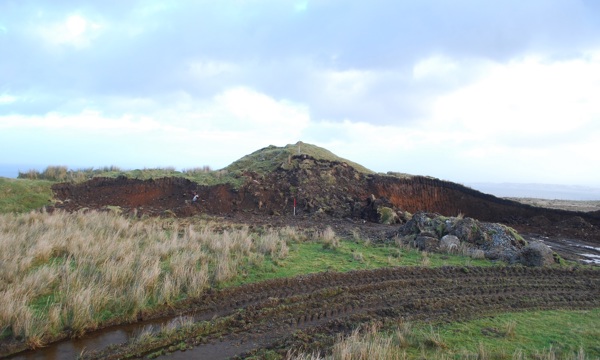Historic Environment Scotland (HES) has welcomed sentencing in the case of extensive and irreversible damage to a prehistoric cairn in Skye.
In 2018, Police Scotland notified HES that Upper Tote Cairn in Skye, which is protected as a scheduled monument in recognition of its national importance, had been dug in to with a mechanical excavator. Under the Ancient Monuments and Archaeological Areas Act 1979, scheduled monuments are protected from any works being done to them without the prior written permission of HES or Scottish Ministers, meaning any works undertaken without this permission are an offence under the 1979 Act.
HES is also a Specialist Reporting Agency under the Act, meaning that it can submit reports to the Crown Office and Procurator Fiscal Service (COPFS) in instances where a scheduled monument is deemed to have been significantly damaged by unauthorised works.
Upper Tote Cairn is a large and impressive conical mound dating to either the Neolithic (4000-2500BC) or Bronze Age (2500-1000BC). Burial mounds of this kind typically contain one, if not several, burials made over decades or centuries. These burials vary in nature from articulated remains to cremated remains, often deposited in large stone-lined chambers, smaller cists (stone ‘chests’), or urns. Such monuments are uncommon on Skye, chambered cairns being particularly scarce, with just 13 examples of the latter being known on the island. It is unclear if Upper Tote Cairn is chambered, but its significance was greatly enhanced by being a largely intact example of a prehistoric cairn that had never been excavated.
Subsequent investigation at the site carried out by HES discovered that a significant part of the scheduled area had been disturbed, with much of the soil around the cairn having been dug away by a mechanical excavator. The cairn itself was badly damaged, with loose cairn material visible where a large part of it had been removed.
As a result of these investigations, HES concluded that this had completely destroyed archaeological information that may have been vital to understanding the cairn and those who built it. In addition, the damage has undermined the remainder of the cairn by destabilising its structural integrity, putting the remaining nationally important archaeology it contains at risk, including the potential disturbance of prehistoric human remains.
Joss Durnan, Senior Ancient Monuments Officer at HES, said: “We welcome the court’s decision in this case - the first we have submitted to COPFS in our capacity as a Specialist Reporting Agency. The fine imposed reflects the seriousness of this offence and the robustness of our report.
“Heritage crime is a serious matter which can cause irreparable damage to our monuments and cultural assets, and cause us to lose pieces of our past forever. Thankfully, serious cases such as this are rare.
“We would like to thank our partners at Police Scotland for their assistance in this case, and we will continue to work closely with them and other agencies, including the COPFS, to investigate and pursue offenders to protect Scotland’s historic environment.”

